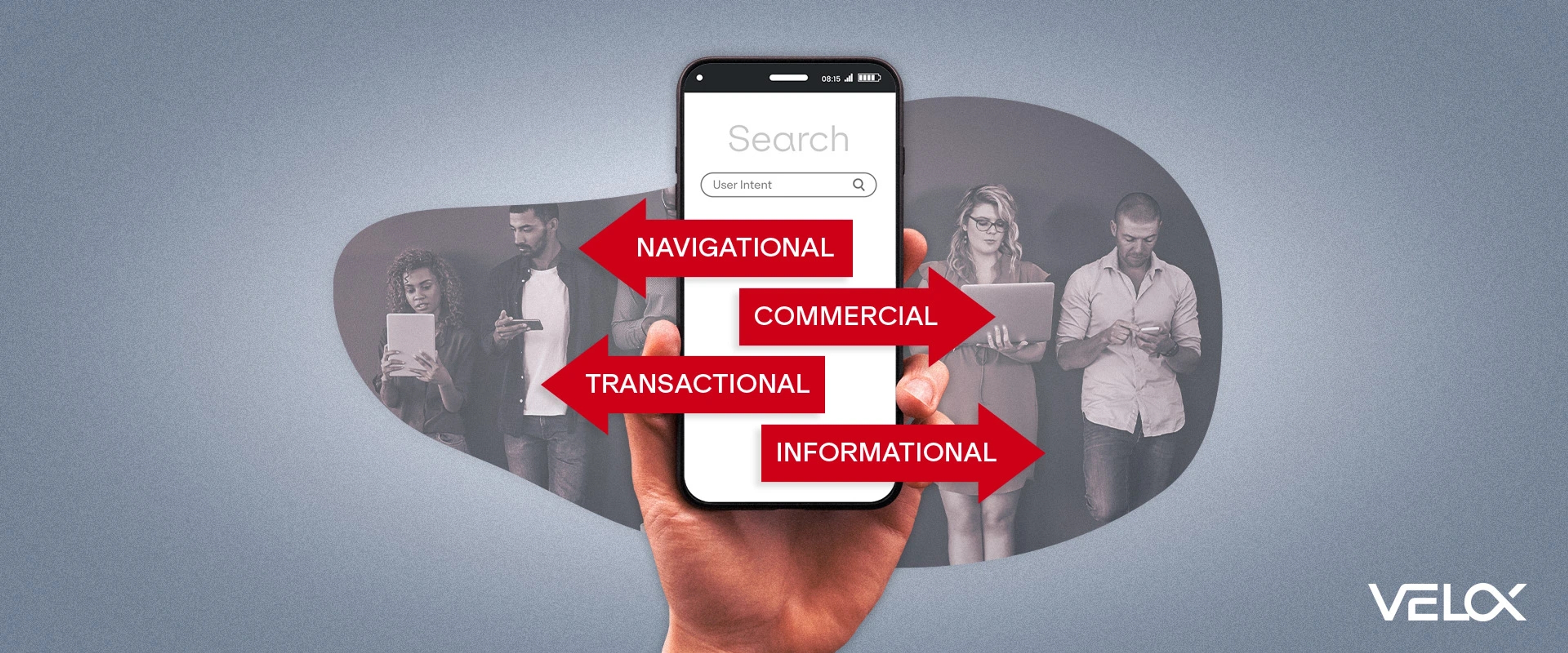

How Understanding User Intent Can Improve Your PPC Campaigns


You can’t just throw keywords at your Google Ads account and see what sticks.
You know this already, which is why you’ve spent countless hours researching keyword opportunities that align with your business and optimizing your landing pages to provide the best user experience while targeting those keywords.
However, the days of targeting a few keywords and letting the account run on autopilot are gone. User intent is more important than ever, and effectively targeting a user’s search intent is the key to driving clicks, conversions, and new revenue.
Search intent is often discussed in an Organic Search sense, but it is just as vital for paid search marketing campaigns.
Here’s what you need to know about user intent and how it should impact your PPC strategy.
What Are the Different Types of User Intent?
When someone enters a query in the search bar, they have a specific goal. This is defined as their intent, of which there are four categories:
- Informational: Someone seeking information or answers to their questions, like “how to train for a marathon.”
- Navigational: Someone looking to navigate to a specific website or webpage, like “Boston marathon signup page.”
- Commercial: Someone looking to buy a product, but wants to learn more about their options, like “best running shoes for marathons.”
- Transactional: Someone ready to make a purchase or take a specific action, like “buy running shoes.”
Every time someone enters a query into Search, they’re expecting relevant results. They don’t want to click from link to link in hopes of finding an answer, and you don’t want users bouncing from your website feeling you couldn’t deliver on their goal.
Not to mention, Google wants users to have the best experience, so they keep returning to the search engine, which is why user experience is at the core of the most recent Google updates. Simply put, optimizing for user intent benefits everyone involved: your brand, searchers, and Google itself.
Why Should You Optimize Your Google Ads for User Intent?
There are many reasons to focus on user intent in your keyword selection process and overall PPC strategy. Identifying the intent behind search terms and building your ad groups around them takes a little extra work, but it can deliver real revenue results.
- Better campaign relevance and Quality Score: If your ads match users’ keyword intent, they’re more relevant, which can improve your Quality Score.
- Boost conversion rates: When your ads are more relevant to a user’s intent, they’re more likely to convert after clicking the ad.
- Reduction in budget waste: With better relevancy, you can pre-qualify searchers directly in SERPs, so only likely converters will click, not people with a different intent.
- Improve ROAS: By reducing budget waste, you can enjoy a more efficient campaign and see a better return on ad spend.
The bottom line: Optimizing for user intent ensures your budget is spent efficiently on high-value, high-intent searchers.
How Can You Identify User Intent Patterns?
Unfortunately, Google doesn’t provide an “intent” label within its first-party keyword research tools (although some third-party tools do), so identifying intent requires some analysis. But once you know what to look for, it’s fairly straightforward.
The best place to start is with your Search Terms Report, detailing the keywords that triggered your ads.
You should review this report often, as the terms and intent behind them can change seasonally, and new queries are always triggering your ads.
As you view the report, look for patterns and categorize the terms by intent.
- Queries with how, why, where, and when, or phrased as a question, indicate informational queries.
- Pay close attention to any queries containing “buy” or other transactional words (cost, review, etc.), as these should be high on your list of target keywords.
- See if your competitors’ names appear anywhere. You can refine your ads to present your brand as a better alternative, although this requires a careful approach.
- Look for your own brand name, too. You can use ads targeting these queries to grow your presence in SERPs or give searchers the final push they need to convert.
Once you’ve categorized your top search terms by intent, you can further optimize your campaign by creating new ad groups and refining your Google Ads copy.
How Should You Structure Your Campaign to Match User Intent?
There are endless ways to structure a Google Ads campaign, and how you create ad groups can vary depending on your business and its goals. However, if you want to emphasize user intent in your Google Ads, consider creating intent-focused ad groups.
Since navigational intent isn’t particularly conversion-oriented, we’ll focus on the other three intents: informational, commercial, and transactional.
Informational Ad Group
This ad group will help you reach searchers in the research phase of their purchasing decision. They might know about your brand, or they might only be looking for your products/services in a generic sense. They might be researching a problem and don’t even realize they need to purchase a product or service to solve it.
Your ads should aim to help users learn more and genuinely educate them, not necessarily selling your products/services. Your landing pages should be helpful blog posts, how-to guides, and other informational resources on your website.
Informational Ad Copy Tips
- Save the hard sell for your other ad groups. People just want to learn more about a topic related to your offerings, so demonstrate your authority in your copy.
- Use phrases like “Learn More” or “Discover How” in your headlines.
- Use the description to detail the information and knowledge a user will gain from reading your landing page.
- Focus on discovery and education in your CTA.
Commercial Ad Group
Now that we’re targeting people in the consideration phase, it’s time to officially introduce your brand, focus on your products/services, and explain why you’re their best choice.
People in this intent group have likely decided they want to make a purchase but are unsure which brand to choose. To help searchers make a decision, you should curate feature/benefit-driven landing pages, highlighting a plethora of options and comparisons.
Commercial Ad Copy Tips
- These ads are focused on helping users compare their options. They want to see what your brand has to offer, so make it easy for them to explore your full range.
- Use phrases like “Compare,” “Explore the Full Range,” or similar in your headlines.
- Highlight various features and benefits for the specific product group in the description copy.
- Encourage users to compare your products and decide for themselves in your CTA copy.
Transactional Ad Group
This final ad group is focused on high-intent searchers who are likely to convert. They might know your brand and products, but need a final push to click the order button.
These ads should help streamline their purchasing process. Make it as easy as possible for them to go from Google to your checkout page. Instead of linking to collection pages, use landing pages for specific products where users can make a direct purchase.
Transactional Ad Copy Tips
- These ads are about grabbing the searcher's attention and encouraging them to make a purchase immediately.
- Be sure to use “Buy,” “Purchase,” “Sign Up,” and other action phrases in the headline.
- Add a sense of urgency in your description. Encourage the user to act quickly or make a purchase today. If you have any new customer promotions, this is a good time to mention them.
- Similar to the headline, use the CTA to encourage users to click the ad and make a purchase.
With these ad groups in place, you’ll be able to target searchers at varying stages of the buying process. Plus, your ads will be more tailored to their intent, improving your relevancy, which can have ripple effects across the whole campaign.
Can PPC Strategies Work Alongside Organic Search?
But where does Organic Search fall in all of this? Can you align your intent-focused PPC campaign with your Organic Search effort?
Yes! In fact, that’s a strategy we recommend for many clients.
There are a few different reasons why PPC and Organic Search work well together.
One benefit of running both organic and paid campaigns is that it provides full-funnel coverage.
With Organic Search, you can target top-of-funnel customers (people in the research phase), leaving room to focus on transactional, bottom-of-funnel searchers (people considering their options or ready to make a purchase) with your PPC strategy. This is more of a divide and conquer approach that works well for some brands.
Plus, with your organic rankings taking up valuable spots and your paid ads at the top and bottom of the SERP, you can visually push out your competitors, which can help your click-through rates and brand image for high-value search results.
Additionally, many brands leverage PPC strategies for quicker revenue gains since their search visibility improves almost immediately after launching the campaign.
Improving Organic Search rankings takes time, but a well-executed paid campaign will start delivering results almost instantaneously. As the Organic Search rankings improve, you can adjust your budget accordingly, putting more into Organic Search and pulling back on ads if it’s right for your business.
However, it can be tricky to manage both strategies with the precision needed to deliver sustainable results, which is why many brands choose to partner with us for their paid and Organic Search campaigns.
Work with the PPC Strategy Experts at VELOX
With user intent guiding your Google Ads campaign, you should start to see improved ad relevancy, higher conversion rates, lower costs per click, and exponential revenue growth. However, as any Google Ads manager knows, optimizing and managing a high-performing campaign is easier said than done.
The PPC strategy experts at VELOX can help maximize your Google Ads efforts. As an ROI-focused agency, we conservatively target 400 to 800% ROI, focused on reducing costs while generating better results for our clients. We are a Google Partner and are recognized for the quality of service and results we deliver.
Contact us today to learn more about our PPC strategies and how we can help your brand.


